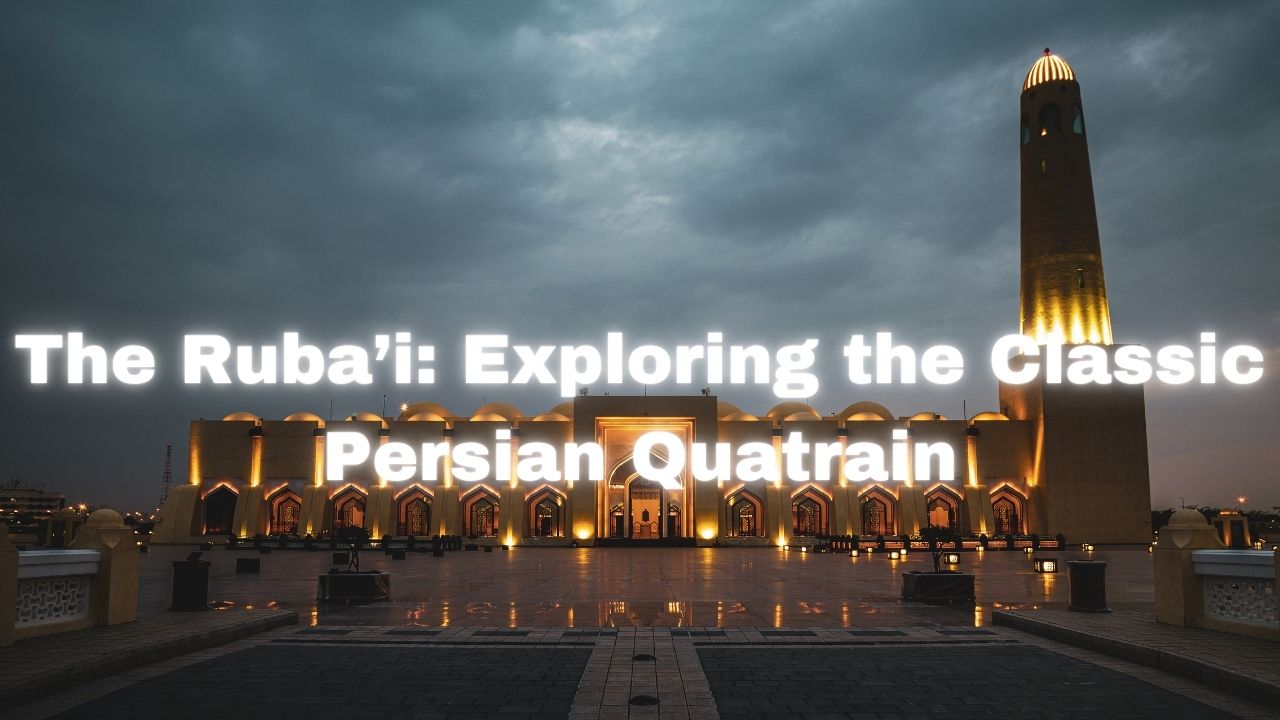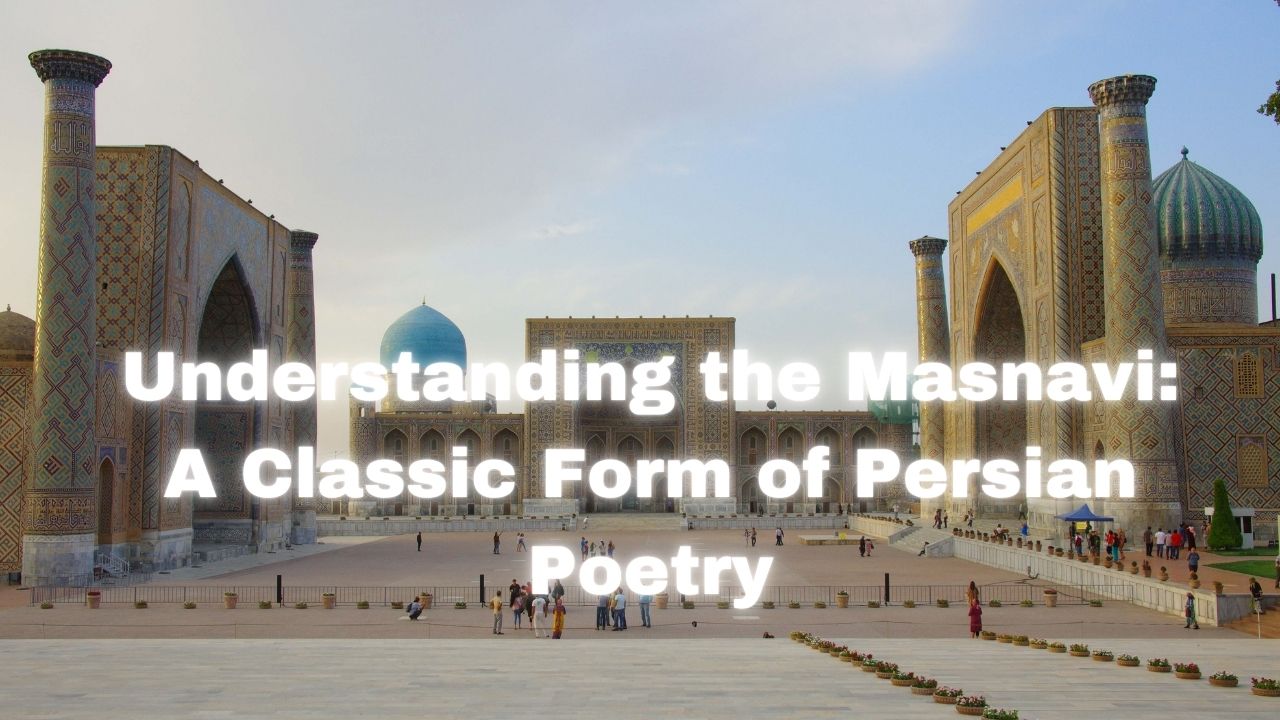A Deep Dive into the Structure, Themes, and Legacy of Persian Ruba’i Poetry
The ruba’i (رباعی), a short yet powerful form of Persian poetry, has captivated readers for centuries with its ability to distill profound truths and complex emotions into just four lines. Best known through the verses of Omar Khayyam, the ruba’i has transcended its Persian origins, becoming one of the most recognizable and beloved forms of classical poetry worldwide.
In this blog post, we will explore the structure of the ruba’i, its common themes, and why this concise poetic form continues to enchant readers and poets alike.
What is a Ruba’i?
The ruba’i (plural: rubaiyat) is a four-line Persian poem, or quatrain, with a specific rhyme scheme and meter. While the ruba’i is short, it carries the weight of deep reflection, often focusing on themes like love, the meaning of life, mortality, and the pursuit of knowledge. In many cases, the final line delivers a punch—a philosophical or emotional revelation that gives the poem its power and resonance.
The brevity of the ruba’i demands precision and clarity from the poet, making it a challenging yet highly rewarding form of expression. Despite its concise format, the ruba’i has been used to convey complex ideas, making it a versatile form in Persian literary tradition.
Structure of a Ruba’i
The ruba’i has a distinct structure that contributes to its lyrical beauty and impact. It is defined by its rhyme scheme and meter:
-
Four Lines (Quatrain): A ruba’i consists of four lines. Each line (called a misra) is typically of the same length, adhering to a specific metrical pattern that gives the poem a rhythmic, flowing quality. The precision of the meter makes the ruba’i musical and easy to recite.
-
Rhyme Scheme: The most common rhyme scheme in a ruba’i is AABA, where the first, second, and fourth lines rhyme, while the third line does not. This gives the poem a distinct structure, with the unrhymed third line often serving as a moment of reflection or contrast before the resolution in the final rhymed line. Less commonly, the ruba’i can also have a rhyme scheme of AAAA, where all four lines rhyme.
Example of AABA rhyme scheme:
"Beneath the stars, I sit and ponder deep,
The night is quiet, yet my thoughts won't sleep,
I ask the moon for secrets it may keep,
But all it shows is silence wide and steep." -
Meter: The ruba’i follows a specific meter known as hazaj meter, though variations can occur. In Persian, this meter typically consists of 13 or 14 syllables per line, with a rhythmic structure that contributes to the poem’s overall harmony. The metrical discipline of the ruba’i is a key part of its beauty, as it combines musicality with brevity.
-
Concise Thought or Idea: Each ruba’i presents a single, self-contained thought or observation, often philosophical or existential in nature. While some Persian poetic forms, like the ghazal, explore broader themes across multiple couplets, the ruba’i delivers its message succinctly in just four lines, offering a snapshot of reflection or insight.
Themes in Ruba’i Poetry
Despite its brevity, the ruba’i is a versatile form that has been used to explore a wide range of themes. Some of the most common include:
-
Life and Death: The ruba’i often reflects on the impermanence of life and the inevitability of death. In this sense, it shares a kinship with the epic themes of Persian literature, but in a condensed form. Poets use the ruba’i to meditate on the fleeting nature of existence and the mysteries of the afterlife.
-
Love and Desire: Like much of Persian poetry, the ruba’i frequently touches on the theme of love, whether it be earthly or divine. In Sufi poetry, love is often a metaphor for the soul’s yearning for union with God, while other rubaiyat focus on the joys and sorrows of romantic love.
-
Philosophical Reflection: Many rubaiyat tackle philosophical questions about the nature of reality, knowledge, and existence. Poets often use the quatrain to ponder deep truths or paradoxes, delivering their conclusions in the final line.
-
Wine and Ecstasy: In many rubaiyat, particularly those influenced by Sufi mysticism, wine serves as a metaphor for spiritual ecstasy. The intoxication of wine represents a state of divine love or enlightenment, a common theme in Persian literature. Omar Khayyam’s verses are filled with imagery of wine and revelry, though they often carry a deeper, symbolic meaning.
-
Fate and Time: The ruba’i is often concerned with the passage of time and the workings of fate. Poets like Omar Khayyam use the form to reflect on how time shapes human destiny, questioning the fairness of fate and pondering the nature of free will.
Famous Examples of Ruba’i Poetry
Several poets have become synonymous with the ruba’i form, elevating it to an art form that is beloved around the world. Here are a few notable examples:
-
Omar Khayyam’s "Rubaiyat": The most famous practitioner of the ruba’i is undoubtedly Omar Khayyam (1048–1131), whose Rubaiyat has become one of the most widely translated and celebrated works of Persian literature. Khayyam’s quatrains explore themes of love, mortality, and the mysteries of life, often with a touch of skepticism and wit. His philosophical musings on fate and the fleeting nature of time have resonated with readers for centuries, making his Rubaiyat an enduring classic. The English translation by Edward FitzGerald in the 19th century brought Khayyam’s work to a global audience, cementing his place as one of the greatest poets of all time.
Example from Khayyam:
"The Moving Finger writes; and, having writ,
Moves on: nor all your Piety nor Wit
Shall lure it back to cancel half a Line,
Nor all your Tears wash out a Word of it." -
Rumi: Although Jalal ad-Din Rumi (1207–1273) is primarily known for his ghazals and his Masnavi, he also composed rubaiyat. In Rumi’s ruba’i, we find a deep exploration of Sufi mysticism, with themes of divine love, spiritual transformation, and the journey of the soul.
Example from Rumi:
"He comes, a moon whose light the sky denies,
He moves, like the cloud before my eyes,
His words pour grace on every living soul,
In his silence, my deepest secrets lie." -
Attar: Another famous Persian poet, Farid al-Din Attar (1145–1221), also contributed to the ruba’i tradition. His quatrains often focus on spiritual enlightenment and the inner journey of the soul, aligning with his broader works like "The Conference of the Birds."
Why the Ruba’i Endures
The ruba’i endures as a timeless form of Persian poetry because of its conciseness, emotional depth, and philosophical richness. In just four lines, a poet can encapsulate profound truths about life, love, and existence. Its brevity makes it accessible, while its layered meanings invite deeper contemplation.
Moreover, the ruba’i's distinct rhyme scheme and musicality give it a pleasing, memorable rhythm, making it a popular form for oral recitation. This has helped the form endure through centuries, passed down through generations in both written and oral traditions.
The appeal of the ruba’i lies in its ability to speak to universal human experiences while maintaining a uniquely Persian voice. It invites readers to pause, reflect, and perhaps find their own truths within the brevity of its lines.
Conclusion: The Power of the Ruba’i
The ruba’i may be a short form of poetry, but it carries immense power. With just four lines, Persian poets have explored some of the most fundamental questions of existence, leaving readers with insights that linger long after the poem is finished.
Whether reflecting on the mysteries of fate, the joy and pain of love, or the quest for spiritual enlightenment, the ruba’i continues to speak to readers across cultures and time periods. Poets like Omar Khayyam have immortalized this form, showing that sometimes the most profound thoughts can be expressed in just a few words.
If you haven’t yet experienced the beauty and depth of the ruba’i, consider reading Khayyam’s Rubaiyat or the works of Rumi and Attar. These poets demonstrate how the ruba’i can offer wisdom and solace in its compact, elegant form.
Take a moment today to reflect on your own experiences with the brief but powerful verses of ruba’i poetry—you might just find that these four-line quatrains offer a lifetime of meaning.





